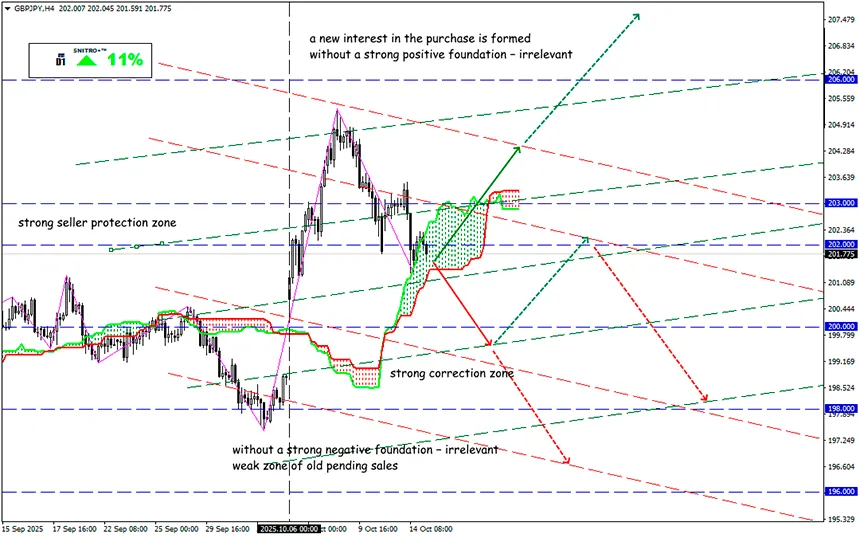Attention! A Perfect Storm on the Market!

GBP/JPY
Key zone: 201.50 - 203.00
Buy: 203.50 (on a strong positive foundation); target 204.50-205.00; StopLoss 202.80
Sell: 201.00 (after a retest of the 202.00 level) ; target 199.00-198.50; StopLoss 201.70
Powell talks about rate corrections, Trump about China, and Beijing about new tariffs. Meanwhile, Japan is facing a new political crisis. The current market suffers from both monetary and geopolitical turbulence, making it especially sensitive to news and officials’ statements.
The head of the Federal Reserve cautiously hinted at rate cuts — but the markets “heard” more than he intended. The trigger for a sharp reassessment of investors’ expectations was Powell’s comments on labor market weakness.
Even without fresh data from the BLS, the release of which was delayed due to the shutdown, the Fed manages to maintain balance between price stability and maximum employment. Powell stated that inflation expectations are now close to the 2% target.
Experts interpreted Powell’s words as a signal of an almost guaranteed rate cut in October. Federal funds futures reflected this, prompting a sharp decline in the dollar across global markets.
The U.S. currency fell by 0.3% against the yen and the franc, while the euro gained 0.3%, holding confidently above $1.16. The dollar index dropped by 0.2%, stopping at 99.055.
The U.S. and China once again exchanged sharp remarks: Trump announced the possibility of halting vegetable oil trade with China, calling it retaliation for Beijing’s refusal to buy American soybeans.
Interestingly, most American farmers would prefer a trade agreement with China over Trump’s subsidies, further complicating the political and economic picture.
At the same time, Beijing imposed sanctions on U.S. subsidiaries of a South Korean shipping giant. Trump threatened to impose additional 100% tariffs on Chinese goods by November 1 and raised the question of canceling his meeting with President Xi Jinping at the APEC summit in South Korea.
It’s clear that both the U.S. and China are trying to strengthen their leverage before new negotiations — but investors on both sides of the conflict are the ones suffering. Any sharp statement by the leaders now can increase pressure on the dollar, while positive news from trade talks may trigger short-term corrections.
In Tokyo, the Komeito Party withdrew from its coalition with the ruling Liberal Democratic Party, reducing LDP’s chances — under its new leader, Takaichi — of forming a full-fledged government. This is highly negative for the economy, though negotiations will continue: party leaders are expected to meet again on October 20. That date will be crucial for the yen, and as it approaches, speculation in yen pairs will likely intensify.
Short-term traders can profit from the current dollar decline, but it is essential to monitor key dates: the Fed meeting on October 28–29, renewed U.S.–China trade talks, and the delayed macroeconomic data releases.
Caution is advised: track signals from the Fed, the BOJ, and China, and adjust your strategies to elevated volatility. The market will remain active — and nervous — in the near term.
So we act wisely and avoid unnecessary risks.
Profits to y’all!


















